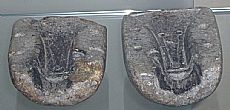Stittenham Bronze Age axehead mould
05 November 2012
- News Type:
- Find of the Month
 This two part mould for casting bronze axeheads was one of two found at Stittenham in Easter Ross in 1847 along with remains of a smelting furnace. It is made of steatite, and dates to the late Bronze Age, c. 950-800 BC. The moulds would have been used to produce socketed axeheads, with decoration on both sides and a loop for tying the axehead to its haft. The channel for pouring molten metal is visible at the top, as are the holes for pegging the mould closed.
This two part mould for casting bronze axeheads was one of two found at Stittenham in Easter Ross in 1847 along with remains of a smelting furnace. It is made of steatite, and dates to the late Bronze Age, c. 950-800 BC. The moulds would have been used to produce socketed axeheads, with decoration on both sides and a loop for tying the axehead to its haft. The channel for pouring molten metal is visible at the top, as are the holes for pegging the mould closed.
Such an axehead is likely to have been a symbol of status rather than a utilitarian object. This object shows that high status metalwork was being made in the area at this period. Other evidence of late Bronze Age metalworking in the Highlands includes Seafield West and North Kessock near Inverness, as well as at Birnie in Moray, Eigg, Cladh Hallam on South Uist and Jarlshof in Shetland. Moulds are known of clay and stone, as well as crucible fragments. The use of steatite for this mould is interesting, since it is generally associated with Shetland and west Scotland; however, a small seam of steatite is reported to outcrop at nearby Ardross. The raw material could either have been traded to the area, but it is also likely that older older objects were melted down.
Late Bronze Age metalwork is found throughout the Highlands, and includes weapons, jewellery and tools.
This mould is on display at the Museum of Scotland in Edinburgh; its pair is on display at the Ashmolean Museum in Oxford.
Further information:
Cowie, Trevor 1988. Magic Metal: Early metalworkers in the North-east (Aberdeen).
Highland Council Historic Environment Record MHG45569 (with references)
CANMORE id 13735 (with references)
Find of the Month Archive
- 25/07/2022 Steatite Vessels
- 10/04/2021 Cruisie lamp in Dunrobin Castle Museum
- 02/03/2021 Medieval Sword Pommel from Sleat, Skye
- 01/02/2021 Hilton of Cadboll Pictish Cross Slab
- 04/01/2021 Gunflint from Stoneyfield, Inverness
- 02/12/2020 Bobbin from Contin Bobbin Mill
- 02/11/2020 Russian Lead Cloth Seal from Cromarty
- 01/10/2020 The Poolewe Hoard
- 04/09/2020 Storr Rock Viking Silver Hoard
- 07/08/2020 Mesolithic bloodstone artefacts from Camas Daraich, Skye
